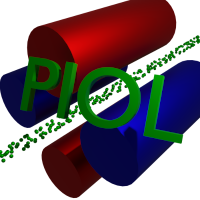Simple particle sources and coordinates¶
This example shows how to create particles and what are the relevant coordinates an user should be aware of.
The full example, sources_and_coordinates.py, is located at examples subdirectory.
Importing piol¶
Piol is imported into a Python program by
import piol
The examples add a parent path to sys.path so that the examples can be run without installing the library first.
import sys
sys.path.append('..')
import piol
Defining the reference particle¶
The reference particle is an imaginary particle which travels through the optical system at the optical axis. In matrix formalism all the coordinates for the reference particle are zero. This can be understood as a transfer matrix is essentially a collection of Taylor polynomes up to required order. The coordinates of the other particles are relative to this reference particle. PIOL needs to know the energy, mass and charge for the reference particle to calculate the transfer matrices and required fields in the optical elements.
PIOL uses SI units for length and time but the energies are given in eV, masses in atomic mass units and charges in multiples of the elementary charge.
See documentation for piol.referenceparticle.ReferenceParticle.
# Creating a reference particle of 50 MeV, 100 u, 18 e.
refple = piol.ReferenceParticle(energy=50e6,mass=100,charge=18)
Creating particles¶
Most of the simulations requires creation of particles which are then tracked through the optical system. There are multiple different source distributions available in PIOL. These are
The GeneralParticleSource is a source where the coordinates are totally independent on each other. The distributions can be individually chosen for each coordinates.
# Creating N=10 particles
N = 10
Source = piol.GeneralParticleSource(
N,
('x',piol.Uniform(-1e-3,1e-3)), # x from [-1,1] mm, [x] = m
('a',piol.Gaussian(mean=0, stddev=50e-3)), # [a] = rad
('y',piol.Uniform(-2e-3,3e-3)), # y from [-2,3] mm, [y] = m
('b',piol.Gaussian(mean=0, stddev=30e-3)), # [b] = rad
('t',0), # [t] = s
('m',np.random.choice( np.arange(refple.mass-3, refple.mass+4 ), N ) ),
('K',refple.energy),('q',refple.charge) )
In PIOL the particle sources are elements as for example a dipole. This means that the when the source element is executed in the optical system, it adds the particles into the system in that moment. Therefore, to see the created particles we need also an element stack, which represents the optical system, and a driver.
Creating the optical system and a driver¶
The class ElementStack is a
special element which which can contain other elements, also other
ElementStack elements.
The elements do not contain a state. An instance of class
Driver is needed to store the tracked
particles.
# Creating a storage for actual elements and appending all elements to it
system = piol.ElementStack(name='example')
system.elements.append( Source )
# Creating a driver which contains all the coordinates and in general
# the state of the calculation.
driver = piol.Driver()
Running the system¶
All the elements have method transfer which takes driver as an argument. After the call the driver includes the coordinates of the particles in its member particles. It is a dictionary of numpy arrays, the coordinate names acting as keys. The coordinates x, a, …, q are those created by the source. There is a special coordinate id which is created by the driver and is unique integer tag for each particle.
Driver has also another member, traj, which is a list of coordinate dictionaries at each profile plane.
The following lines runs the system and prints all particle coordinates after the system.
# Running the system (only one element -- the source)
system.transfer(driver)
# Printing all coordinates after the optical system
for key in driver.particles:
print( "{:13s} ".format(key), end='' )
print()
for index in range( len( driver.particles['id'] ) ):
for key in driver.particles:
print( "{:<13g} ".format( driver.particles[key][index] ), end='' )
print()
The result can be like:
jhsaren@myyra:~/git/piol/examples$ python3 sources_and_coordinates.py
id x a y b t m K q
0 -0.000653651 -0.0151447 0.00096545 0.0450925 0 102 5e+07 18
1 0.000218771 -0.0261737 0.00237408 -0.00452792 0 101 5e+07 18
2 0.000664871 0.0778851 0.00216692 0.025384 0 98 5e+07 18
3 0.000166958 -0.0549145 -0.00125974 0.0239548 0 100 5e+07 18
4 0.000324334 -0.0116778 -0.000909095 0.0220662 0 99 5e+07 18
5 7.22529e-05 0.0750293 -0.00124698 -0.0405254 0 98 5e+07 18
6 0.00074122 -0.0139119 0.000578136 0.00708552 0 101 5e+07 18
7 -0.000855707 0.0620997 -6.78905e-06 0.00603737 0 97 5e+07 18
8 -0.000470933 0.0305785 0.00158259 -0.0185863 0 103 5e+07 18
9 -0.000774972 0.0960833 0.00141956 0.0226045 0 102 5e+07 18
The full example¶
1# This example is documented in
2# ../docs/source/example_source_and_coordinates.rst Changing the line
3# numbers will mess the example documentation. So, check the
4# documentation if changing anything here.
5
6import numpy as np
7# Next line can be removed if piol is installed in the system
8import sys
9sys.path.append('..')
10import piol
11
12# -- line 12 --
13# Creating a reference particle of 50 MeV, 100 u, 18 e.
14refple = piol.ReferenceParticle(energy=50e6,mass=100,charge=18)
15
16# -- line 16 --
17
18
19# -- line 19 --
20# Creating N=10 particles
21N = 10
22Source = piol.GeneralParticleSource(
23 N,
24 ('x',piol.Uniform(-1e-3,1e-3)), # x from [-1,1] mm, [x] = m
25 ('a',piol.Gaussian(mean=0, stddev=50e-3)), # [a] = rad
26 ('y',piol.Uniform(-2e-3,3e-3)), # y from [-2,3] mm, [y] = m
27 ('b',piol.Gaussian(mean=0, stddev=30e-3)), # [b] = rad
28 ('t',0), # [t] = s
29 ('m',np.random.choice( np.arange(refple.mass-3, refple.mass+4 ), N ) ),
30 ('K',refple.energy),('q',refple.charge) )
31# -- line 31 --
32
33
34# -- line 34 --
35# Creating a storage for actual elements and appending all elements to it
36system = piol.ElementStack(name='example')
37system.elements.append( Source )
38
39# Creating a driver which contains all the coordinates and in general
40# the state of the calculation.
41driver = piol.Driver()
42# -- line 42 --
43
44
45# -- line 45 --
46# Running the system (only one element -- the source)
47system.transfer(driver)
48
49# Printing all coordinates after the optical system
50for key in driver.particles:
51 print( "{:13s} ".format(key), end='' )
52print()
53for index in range( len( driver.particles['id'] ) ):
54 for key in driver.particles:
55 print( "{:<13g} ".format( driver.particles[key][index] ), end='' )
56 print()
57# -- line 57 --
58
